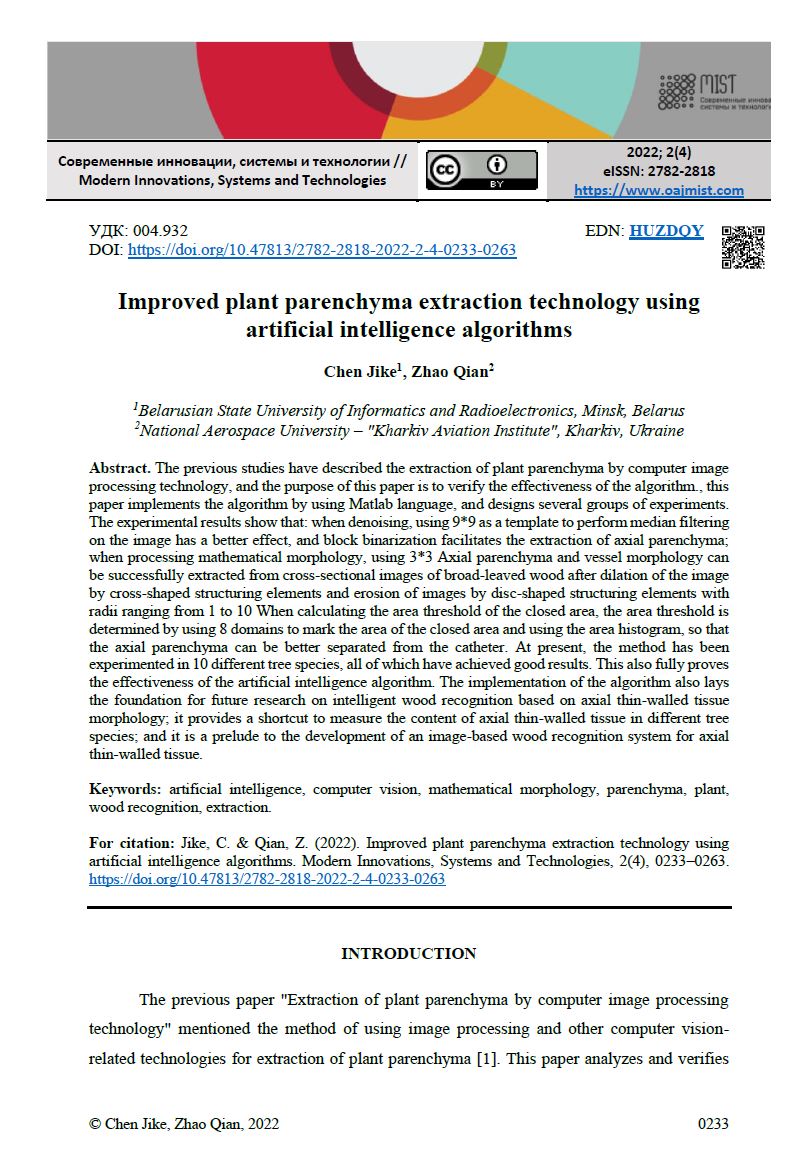Improved plant parenchyma extraction technology using artificial intelligence algorithms
DOI:
https://doi.org/10.47813/2782-2818-2022-2-4-0233-0263Ключевые слова:
Artificial intelligence, Computer vision, Mathematical morphology, Parenchyma, Plant, Wood recognition, ExtractionАннотация
The previous studies have described the extraction of plant parenchyma by computer image processing technology, and the purpose of this paper is to verify the effectiveness of the algorithm., this paper implements the algorithm by using Matlab language, and designs several groups of experiments. The experimental results show that: when denoising, using 9*9 as a template to perform median filtering on the image has a better effect, and block binarization facilitates the extraction of axial parenchyma; when processing mathematical morphology, using 3*3 Axial parenchyma and vessel morphology can be successfully extracted from cross-sectional images of broad-leaved wood after dilation of the image by cross-shaped structuring elements and erosion of images by disc-shaped structuring elements with radii ranging from 1 to 10 When calculating the area threshold of the closed area, the area threshold is determined by using 8 domains to mark the area of the closed area and using the area histogram, so that the axial parenchyma can be better separated from the catheter. At present, the method has been experimented in 10 different tree species, all of which have achieved good results. This also fully proves the effectiveness of the artificial intelligence algorithm. The implementation of the algorithm also lays the foundation for future research on intelligent wood recognition based on axial thin-walled tissue morphology; it provides a shortcut to measure the content of axial thin-walled tissue in different tree species; and it is a prelude to the development of an image-based wood recognition system for axial thin-walled tissue.
Библиографические ссылки
Jiangfeng C., Yikai D. Extraction of plant parenchyma by computer image processing technology. Informatics. Economics. Management. 2022; 1(2): 0134–0167. https://doi.org/ 10.47813/2782-5280-2022-1-2-0134-0167
Jiang Z. Development of IT Industry in China in the New Age: Doctoral dissertation. 2008.
He W., Hu W., Yang Y., Shen H., Wu Y., Song Y., Liu X. Improved left- and right-hand tracker using computer vision. Student research. 2022: 21-29.
Hermanson J. C., Wiedenhoeft A. C. A brief review of machine vision in the context of automated wood identification systems. IAWA journal. 2011; 32(2): 233-250.
Zhao C., Blekanov I. Two Towers Collaborative Filtering Algorithm for Movie Recommendation. Management processes and sustainability. 2021; 8(1): 397-401.
Yuan C., Liu X., Zhang Z. The Current Status and progress of Adversarial Examples Attacks. Proceedings of 2021 International Conference on Communications, Information System and Computer Engineering (CISCE); May 2021; IEEE; 2021: 707-711.
Cui K. P., Zhai X. R., Wang H. J. A survey on wood recognition using machine vision. Adv For Lett, 2013; 2: 61-66.
Liu X., Xie X., Hu W., Zhou H. The application and influencing factors of computer vision: focus on human face recognition in medical field. Science, education, innovations: topical issues and modern aspects. 2022: 32-37.
Shen G., He K., Jin J., Chen B., Hu W., Liu X. Capturing and analyzing financial public opinion using nlp and deep forest. Scientific research of students and pupils. 2022: 66-71.
Cui K. P., Zhai X. R., Wang H. J. A survey on wood recognition using machine vision. Adv For Lett. 2013; 2: 61-66.
Chen B., Song Y., Cheng L., He W., Hu W., Liu X., Chen J. A review of research on machine learning in stock price forecasting. Science and modern education: topical issues, achievements and innovations. 2022: 56-62.
Liu Z., Feng R., Chen H., Wu S., Gao Y., Gao Y., Wang X. Temporal Feature Alignment and Mutual Information Maximization for Video-Based Human Pose Estimation. Proceedings of the IEEE/CVF Conference on Computer Vision and Pattern Recognition; 2022: 11006-11016.
de Andrade B. G., Basso V. M., de Figueiredo Latorraca J. V. Machine vision for field-level wood identification. IAWA Journal. 2020; 41(4): 681-698.
Liu X., Liu W., Yi S., Li J. Research on Software Development Automation Based on Microservice Architecture. Proceedings of the 2020 International Conference on Aviation Safety and Information Technology; October 2020; 2020: 670-677.
He K., Song Y., Shen G., He W., Liu W. Based on deep reinforcement learning and combined with trends stock price prediction model. Topical issues of modern scientific research. 2022: 156-166.
Souza D. V., Santos J. X., Vieira H. C., Naide T. L., Nisgoski S., Oliveira L. E. S. An automatic recognition system of Brazilian flora species based on textural features of macroscopic images of wood. Wood Science and Technology. 2020; 54(4): 1065-1090.
Wu J., Lee P. P., Li Q., Pan L., Zhang J. CellPAD: Detecting performance anomalies in cellular networks via regression analysis. Proceedings of 2018 IFIP Networking Conference (IFIP Networking) and Workshops; May 2018; IEEE; 2018: 1-9.
Ou S., Gao Y., Zhang Z., Shi C. Polyp-YOLOv5-Tiny: A Lightweight Model for Real-Time Polyp Detection. Proceedings of 2021 IEEE 2nd International Conference on Information Technology, Big Data and Artificial Intelligence (ICIBA); December 2021; IEEE; 2021; 2: 1106-1111.
Chen S., Awano T., Yoshinaga A., Sugiyama J. Flexural behavior of wood in the transverse direction investigated using novel computer vision and machine learning approach. Holzforschung, 2022; 76(10): 875-885.
Xiaomin L., Yuehang S., Borun C., Xiaobin L., Weijun H. A novel deep learning based multi-feature fusion method for drowsy driving detection. Industry and agriculture. 2022: 34-49.
Zhouyi X., Weijun H., Yanrong, H. Intelligent acquisition method of herbaceous flowers image based on theme crawler, deep learning and game theory. Kronos. 2022; 7(4(66)): 44-52.
Ergun H., Uzun Y. Artificial intelligence methods applied in wood species identification. Current Studies in Artificial Intelligence, Virtual Reality and Augmented Reality. 2022: 136-145.
Xie Z., Hu W., Fan Y., Wang Y. Research on multi-target recognition of flowers in landscape garden based on ghostnet and game theory. Development of science, technology, education in the 21st century: topical issues, achievements and innovations. 2022: 46-56.
Hu W., Zheng T., Chen B., Jin J., Song Y. Research on product recommendation system based on deep learning. Basic and applied scientific research: current issues, achievements and innovations. 2022: 116-124.
Ibrahim I., Khairuddin A. S. M., Arof H., Yusof R., Hanafi E. Statistical feature extraction method for wood species recognition system. European journal of wood and wood products. 2018; 76(1): 345-356.
Yin L. The time-consistency of optimality principles in multistage cooperative games with spanning tree: Master's thesis. 2017.
He W., Hu W., Wu Y., Sun L., Liu X., Chen B. Development history and research status of convolutional neural networks. Student scientific forum. 2022: 28-36.
Pedreschi F., León J., Mery D., Moyano P. Development of a computer vision system to measure the color of potato chips. Food Research International. 2006; 39(10): 1092-1098.
Yin L. (). The dynamic Shapley Value in the game with spanning tree. Proceedings of 2016 International Conference Stability and Oscillations of Nonlinear Control Systems; June 2016; IEEE; 2016: 1-4.
Xie Z., Hu W., Zhu J., Li B., Wu Y., He W., Liu X. Left- and right-hand tracker based on convolutional neural network. Topical issues of modern science of education. 2022: 61-67.
Jiajun J., Wanting Y. The use of computer vision technology in intelligent agricultural machinery. Science and education: preserving the past, creating the future. 2022: 9.
Xu J., Chen J., Li B., Li X. Analysis of the bargaining game and buyer's benefit model. Modern scientific research: topical issues, achievements and innovations. 2022: 91-96.
Jiajun J., Yuehang S., Geya S., Borun C., Kun H., Weijia L., Zhouyi X., Yanyou W., Yu X., Weijun H. The use of a discrete differential algorithm for deep learning has been the focus of research into the technologies around visual target tracking. Industry and agriculture. 2022: 66-78.
Sun Q., Zhao C., Petrosian O., Li Y. Power allocation in wireless cellular networks: stochastic algorithm-based approach. Management processes and sustainability. 2022; 9(1): 357-362.
Petrosian O., Shi L., Li Y., Gao H. Moving information horizon approach for dynamic game models. Mathematics. 2019; 7(12): 1239.
Wang H., Qi H., Li W., Zhang G., Wang P. A GA-based automatic pore segmentation algorithm. Proceedings of the first ACM/SIGEVO Summit on Genetic and Evolutionary Computation; 2009: 985-988.
Ma R., Zhang Y., Liu J., Li Y., Petrosian O., Krinkin K. Forecasting and XAI for Applications Usage in OS. Machine Learning and Artificial Intelligence. IOS Press; 2022: 17-27.
Ding Z. H., Yang F. W., Li Y., Petrosian O., Liu Y. Management processes and sustainability. 2022; 9(1): 311-318.
Yin L. Dynamic Shapley Value for 2-stage cost sharing game with perishable products. Proceedings of 2017 29th Chinese Control and Decision Conference (CCDC); May 2017; IEEE; 2017: 3770-3774.
Yin L. Dynamic Shapley value in the game with spanning forest. Proceedings of 2017 Constructive Nonsmoothed Analysis and Related Topics (dedicated to the memory of V. F. Demyanov); May 2017; IEEE (CNSA); 2017: 1-4.
Yin L. The dynamic Nash bargaining solution for 2-stage cost sharing game. Contributions to Game Theory and Management. 2020; 13(0): 296-303.
Petrosian O., Nastych M., Li Y. The Looking Forward Approach in a Differential Game Model of the Oil Market with Non-transferable Utility. Proceedings of Frontiers of Dynamic Games. Birkhäuser, Cham; 2020: 215-244.
Hu W., Liu X., Xie Z. Ore image segmentation application based on deep learning and game theory. World science: problems and innovations. 2022: 71-76.
Cheng M., Li Y. New characteristic function for two stage games with spanning tree. Contributions to Game Theory and Management. 2021; 14: 59-71.
Li Y., Petrosyan O. L., Zou J. Dynamic shapely value in the game with perishable goods. Contributions to Game Theory and Management. 2021; 14(0): 273-289.
Li Y. Dynamic stability of optimality principles in cooperative multistage games with spanning tree: Master’s thesis. Saint Petersburg. 2021. 80.
Yin L. Dynamic Shapley Value for Two-Stage Cost Sharing Game. Proceedings of International Conference Dedicated to the Memory of Professor Vladimir Zubov. October 2020. Springer, Cham; 2020: 457-464.
Li I. Construction of a strongly dynamically stable kernel in cooperative games with complete information. Management processes and sustainability. 2015; 2(1): 635-640.
Lin Y., Chen D., Liang S., Xu Z., Qiu Y., Zhang J., Liu X. Color classification of wooden boards based on machine vision and the clustering algorithm. Applied Sciences. 2020; 10(19): 6816.

Загрузки
Опубликован
Как цитировать
Выпуск
Раздел
Лицензия
Copyright (c) 2022 Chen Jike, Zhao Qian

Это произведение доступно по лицензии Creative Commons «Attribution» («Атрибуция») 4.0 Всемирная.
Журнал MIST - «Modern Innovations, Systems and Technologies» / «Современные инновации, системы и технологии» публикует материалы на условиях лицензии CreativeCommons Attribution 4.0 International (CC BY 4.0), размещенной на официальном сайте некоммерческой корпорации Creative Commons: 
This work is licensed under a Creative Commons Attribution 4.0 International License.
Это означает, что пользователи могут копировать и распространять материалы на любом носителе и в любом формате, адаптировать и преобразовывать тексты, использовать контент для любых целей, в том числе коммерческих. При этом должны соблюдаться условия использования — указание автора оригинального произведения и источника: следует указывать выходные данные статей, предоставлять ссылку на источник, а также указывать, какие изменения были внесены.























